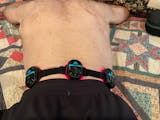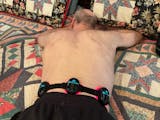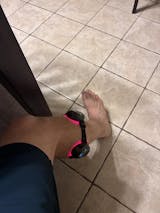A torn rotator cuff can be a debilitating injury, affecting your ability to perform simple tasks and enjoy your favorite activities. Traditional treatments like surgery or medications are commonly recommended, but many people are seeking natural ways to heal. This article will guide you through some of the most effective natural healing methods for a torn rotator cuff, with a special focus on medical-grade red light therapy devices as a powerful tool to promote recovery.
Understanding Rotator Cuff Injuries
What Is a Rotator Cuff and Its Function
The rotator cuff is a group of muscles and tendons that stabilize your shoulder joint. They allow you to lift and rotate your arm, which is essential for everyday movements like reaching, lifting, or throwing. When one or more of these tendons tear, it can cause pain, weakness, and limited movement, significantly impacting your daily life.
Common Causes of Rotator Cuff Tears
Rotator cuff injuries are often the result of repetitive overhead movements, trauma, or simply age-related wear and tear. Athletes who participate in sports like baseball, swimming, or tennis, as well as workers involved in tasks that require heavy lifting or overhead motions, are especially at risk.

Symptoms of a Torn Rotator Cuff
If you have a torn rotator cuff, you may experience a variety of symptoms, including persistent shoulder pain, especially at night or with certain movements, weakness in the arm, or difficulty lifting objects above your head. In some cases, there may also be a clicking or popping sound when you move your shoulder.
Natural Healing Methods for a Torn Rotator Cuff
Rest and Avoiding Further Stress
Rest is one of the most important factors in healing a torn rotator cuff. Avoiding activities that stress the shoulder, like lifting heavy objects or engaging in overhead movements, can prevent further damage. Allowing time for the body to heal naturally is crucial in promoting recovery.
Applying Cold Therapy for Inflammation Relief
Cold therapy is effective in reducing inflammation and numbing the pain of a torn rotator cuff. Applying a cold pack to the affected area for 15-20 minutes several times a day can help manage swelling and provide temporary pain relief, especially in the first 48 hours following the injury.
Heat Therapy for Pain Relief and Muscle Relaxation
Once the initial inflammation has reduced, applying heat can be beneficial for muscle relaxation and increased blood flow to the injured area. A warm compress or heating pad can help soothe the muscles around the rotator cuff, promoting healing and relieving stiffness.

The Role of Medical-Grade Red Light Therapy Devices in Healing
How Red Light Therapy Works for Healing
Medical-grade red light therapy devices use low-wavelength red and near-infrared light to penetrate deep into the tissues. This light stimulates cellular processes that promote healing, such as increased blood circulation and collagen production. The therapy can reduce inflammation, enhance tissue repair, and alleviate pain.
Benefits of Using Medical-Grade Red Light Therapy Devices
Using high-quality red light therapy devices can provide multiple benefits during recovery. It helps speed up healing by encouraging the repair of damaged tissues, reducing inflammation in the rotator cuff area, and promoting the regeneration of collagen. These devices can also reduce pain, making it easier to engage in physical therapy exercises.
How to Use Red Light Therapy for a Rotator Cuff Injury
To use red light therapy module - PRUNGO FluxGo effectively, position the device so that the light targets the injured area. Sessions typically last 10-20 minutes and should be done 3-5 times per week, depending on the device and your specific needs. Always follow the manufacturer’s guidelines for best results.

Exercises to Strengthen the Rotator Cuff Naturally
Gentle Stretching to Improve Flexibility
After the initial healing phase, stretching exercises are crucial for regaining flexibility and preventing stiffness. Gentle stretches that target the shoulder and upper back can improve your range of motion, easing the discomfort associated with a torn rotator cuff.
Rotator Cuff Strengthening Exercises
Strengthening the muscles around the shoulder joint is key to preventing future injuries. Begin with low-resistance exercises like isometric holds or resistance band exercises to gradually rebuild strength. These exercises help support the shoulder joint, reducing the risk of further tears.
Isometric Exercises for Muscle Activation
Isometric exercises are beneficial during the early stages of recovery. These exercises involve contracting the muscles without moving the shoulder joint. They help activate the muscles without putting stress on the injured area, which is important when you're still recovering from a tear.
The Importance of Nutrition in Healing a Rotator Cuff
Key Nutrients for Tissue Repair
Proper nutrition plays an important role in healing. Protein is essential for tissue repair, while vitamin C supports collagen production, which is necessary for tendon recovery. Omega-3 fatty acids, found in foods like fish and flaxseeds, can help reduce inflammation in the injured area.
Anti-Inflammatory Foods to Include in Your Diet
Certain foods, like turmeric, ginger, and berries, have natural anti-inflammatory properties that can help reduce swelling and pain in the shoulder. Including these in your diet can enhance the body's ability to heal naturally and speed up recovery.
Supplements That May Support Rotator Cuff Recovery
In addition to a balanced diet, supplements like glucosamine, chondroitin, and collagen peptides can support joint health and tendon repair. These supplements provide the body with the building blocks it needs to heal torn tissues and improve overall joint function.

Alternative Therapies for Rotator Cuff Injuries
Acupuncture for Pain Management
Acupuncture is an alternative therapy that can help reduce pain and promote healing. By targeting specific pressure points in the body, acupuncture may alleviate pain and improve circulation in the shoulder, helping accelerate the healing process.
Massage Therapy for Muscle Recovery
Massage therapy is another natural treatment that can help release tension in the muscles surrounding the rotator cuff. Therapeutic massage can promote blood flow, relieve muscle spasms, and reduce pain, all of which are beneficial for a faster recovery.
Chiropractic Care for Shoulder Alignment
Chiropractors can help improve the alignment of your shoulder, ensuring that the joint functions properly. This type of care can help restore normal movement patterns, prevent further injury, and aid in the recovery of a torn rotator cuff.

When to Seek Professional Medical Attention
Signs You Should See a Doctor for a Rotator Cuff Injury
If you experience intense pain, significant weakness, or a limited range of motion that doesn't improve with natural treatments, it may be time to see a doctor. Professional evaluation can help determine the extent of the injury and whether more invasive treatments are necessary.
The Role of Physical Therapy in Rotator Cuff Recovery
Physical therapy is essential for rehabilitating a torn rotator cuff. A physical therapist can guide you through exercises designed to strengthen the shoulder, improve mobility, and reduce the risk of future injuries. They can also provide treatments like ultrasound or electrical stimulation to further aid in healing.
Surgical Intervention: When Is It Necessary
While most rotator cuff injuries can heal with conservative treatments, surgery may be necessary for large or chronic tears. A doctor will consider your age, activity level, and the severity of the injury when determining whether surgery is the best option.
Conclusion
Healing a torn rotator cuff naturally involves a combination of rest, targeted exercises, proper nutrition, and therapies like medical-grade red light therapy devices. While these methods can significantly speed up the recovery process, it’s essential to monitor your progress and consult a healthcare professional when needed. Incorporating treatments such as red light therapy can accelerate tissue repair and reduce inflammation, making it a powerful tool in the healing process. To experience the benefits of red light therapy, consider investing in a Red light panel or Red light therapy mask from Prungo, a trusted brand that provides high-quality devices designed to support your recovery journey. With the right care and treatment, you can return to your normal activities stronger and more resilient than ever before.
















Share:
More Than a Button: How to Find the "Right" Red Light Therapy Dose for Real Results
Why Does My Lower Back Hurt